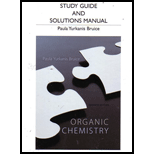
Concept explainers
(a)
Interpretation:
The effect on the
Concept Introduction:
SN2 Reaction: It is a nucleophilic substitution reaction in which the rate determining step depends on both of the molecules involved. The bond making and the bond breaking process happens simultaneously in this reaction resulting in the formation of product with inversed configuration.
Structure of the substrate plays major role in the reactivity of
Rate constant: Rate constant is an expression used to relate the rate of a reaction to the concentration of reactants participating in the reaction.
Rate of SN2 reaction between an
(b)
Interpretation:
The effect on the rate of the reaction should be explained when the solvent is change to ethanol.
Concept Introduction:
Structure of the substrate plays major role in the reactivity of
Protic solvent are polar solvent molecules which donates hydrogen bond and forms a strong ion-dipole interaction with the nucleophile.
Aprotic solvent are polar solvent molecules which do not have hydrogen having a partial positive charge and does not form any ion-dipole interactions with the nucleophile.
The stronger base is always a better nucleophile in an aprotic solvent.
(c)
Interpretation:
The effect on the rate of the reaction should be explained when the nucleophile is changed to ethanol.
Concept Introduction:
Structure of the substrate plays major role in the reactivity of
Rate of SN2 reaction between an alkyl halide and nucleophile can be given as,’
The rate of the reaction increases when an alkyl halide reacts with a better nucleophile
(d)
Interpretation:
The effect on the rate of the reaction should be explained when the alkyl halide is changed to 1-chlorobutane.
Concept Introduction:
Structure of the substrate plays major role in the reactivity of
Leaving group: it is a fragment that leaves substrate with a pair of electrons via heterolytic bond cleavage.
Down the group, atom size decreases which in turn reduces the tendency of atom for donating electrons and hence basicity decreases making them a better leaving group.
(e)
Interpretation:
The effect on the rate of the reaction should be explained when the alkyl halide is changed to 2-bromobutane.
Concept Introduction:
Structure of the substrate plays major role in the reactivity of
Carbocation: It is carbon ion that bears a positive charge on it. The increasing stability order of carbocation is as follows,
Primary carbocation < secondary carbocation < tertiary carbocation
Want to see the full answer?
Check out a sample textbook solution
Chapter 9 Solutions
Organic Chemistry
 ChemistryChemistryISBN:9781305957404Author:Steven S. Zumdahl, Susan A. Zumdahl, Donald J. DeCostePublisher:Cengage Learning
ChemistryChemistryISBN:9781305957404Author:Steven S. Zumdahl, Susan A. Zumdahl, Donald J. DeCostePublisher:Cengage Learning ChemistryChemistryISBN:9781259911156Author:Raymond Chang Dr., Jason Overby ProfessorPublisher:McGraw-Hill Education
ChemistryChemistryISBN:9781259911156Author:Raymond Chang Dr., Jason Overby ProfessorPublisher:McGraw-Hill Education Principles of Instrumental AnalysisChemistryISBN:9781305577213Author:Douglas A. Skoog, F. James Holler, Stanley R. CrouchPublisher:Cengage Learning
Principles of Instrumental AnalysisChemistryISBN:9781305577213Author:Douglas A. Skoog, F. James Holler, Stanley R. CrouchPublisher:Cengage Learning Organic ChemistryChemistryISBN:9780078021558Author:Janice Gorzynski Smith Dr.Publisher:McGraw-Hill Education
Organic ChemistryChemistryISBN:9780078021558Author:Janice Gorzynski Smith Dr.Publisher:McGraw-Hill Education Chemistry: Principles and ReactionsChemistryISBN:9781305079373Author:William L. Masterton, Cecile N. HurleyPublisher:Cengage Learning
Chemistry: Principles and ReactionsChemistryISBN:9781305079373Author:William L. Masterton, Cecile N. HurleyPublisher:Cengage Learning Elementary Principles of Chemical Processes, Bind...ChemistryISBN:9781118431221Author:Richard M. Felder, Ronald W. Rousseau, Lisa G. BullardPublisher:WILEY
Elementary Principles of Chemical Processes, Bind...ChemistryISBN:9781118431221Author:Richard M. Felder, Ronald W. Rousseau, Lisa G. BullardPublisher:WILEY





